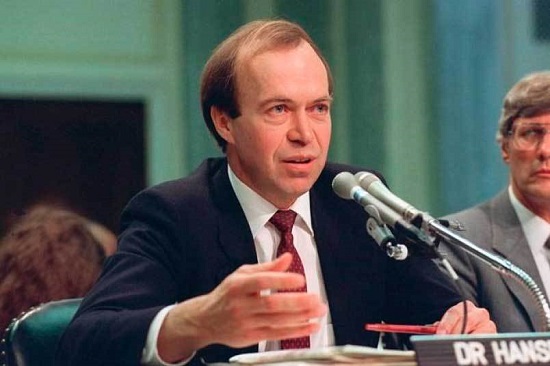
In 1988 James Hansen gave his famous testimony to the US Senate. For the short story, go to Tamino at Open Mind. For the longer story, Gavin Schmidt at RealClimate, plus the commentary thread is best.
Hansen told the politicians that our production of greenhouse gases, principally CO2, N2O, CH4 and CFC, were warming the climate. He said temperatures would go up in the coming years:
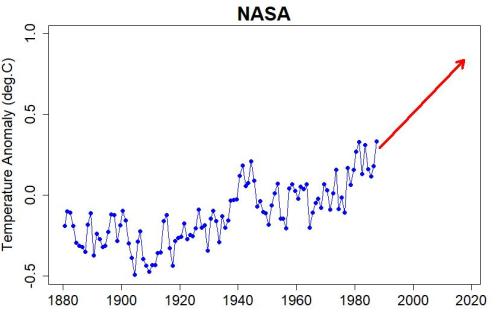
This is what happened:
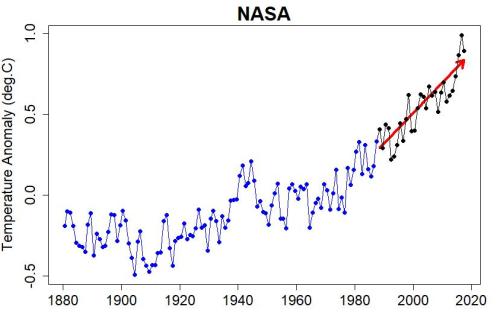
That’s from Open Mind. The long story is not quite so neat. Hansen used modelling developed in 1983-84, from which he projected three scenarios, showing temperature rise against a 1964-1983 base. From Nick Stokes at moyhu, here’s the original graph:
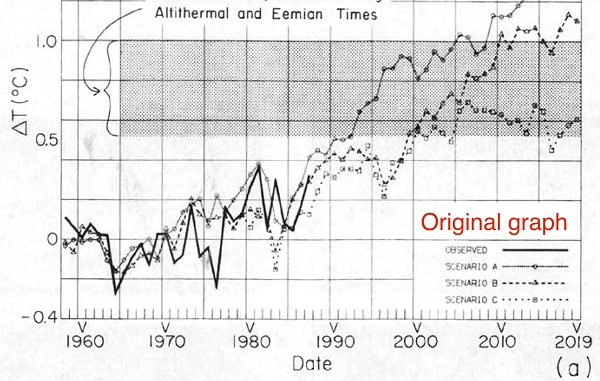
From Stokes’ earlier post, Hansen’s Scenario A represented what he thought would happen if CO2 doubled by 2030. Scenario B was based on CO2 doubling by 2060. In Scenario C emissions are constrained so that doubling never occurs and net forcing ceases to grow from 2000. The band across the graph shows what happened during the Eemian interglacial period (with only about 300 ppm), which began 130,000 years ago and ended 115,000 years ago. Hansen said that Scenario B was “perhaps the most plausible”.
Critical to comparisons with the Eemian is that temperatures persisted over millennia during that interglacial, so longer term effects came into play. Hansen’s graph is only considering short-term (so-called Charney effects) which play out over a few decades.
Gavin Schmidt explains that when the modelling was designed the Montreal Protocol (September 1987) had not been signed, which basically accounts for the difference between Scenario B and what happened. So here’s Scenario B corrected:
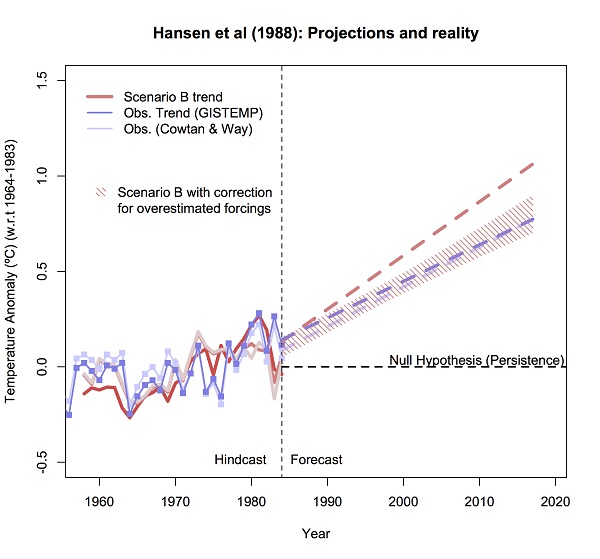
Hansen told the Senate that he was 99% certain that we were already experiencing human-induced global warming. Here’s the graph that shows a continuity of natural forcings, ie excluding human forcings, compared to what happened:
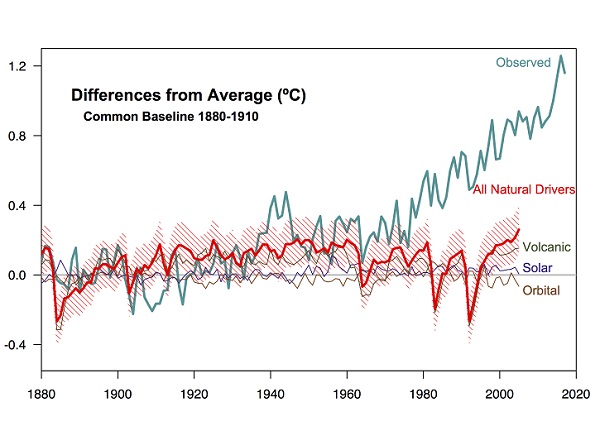
The shading shows a 95% confidence interval around the “all natural forcings” simulations. 95% confidence is associated with data more than ~2.6 standard deviations outside of the expected range. In fact from 1985 onwards the variation was 3 standard deviations or greater.
We can conclude from this that Hansen knew what he was talking about.
On climate sensitivity, the temperature change from doubling CO2, Schmidt says:
The equilibrium climate sensitivity of the Hansen model was 4.2ºC for doubled CO2, and so you could infer that a model with a sensitivity of say, 3.6ºC, would likely have had a better match (assuming that the transient climate response scales with the equilibrium value which isn’t quite valid).
For more detail on climate sensitivity, see previous posts:
The short story is that long-term effects, including ice sheet decay, will play out over millennia. The concept that takes this into account is Earth System Sensitivity (ESS), which has an estimated value up around 6°C.
A climate where temperatures increase by 6°C is no trivial matter. A temperature increase of 4°C is usually associated with the risk of the end of civilisation as we know it, and is likely to trigger tipping points which take the temperature higher.
John Englander a few years ago looked at the three graphs which relate CO2 levels, global surface temperatures and sea level. He is especially concerned about the top-right green line circled in red:
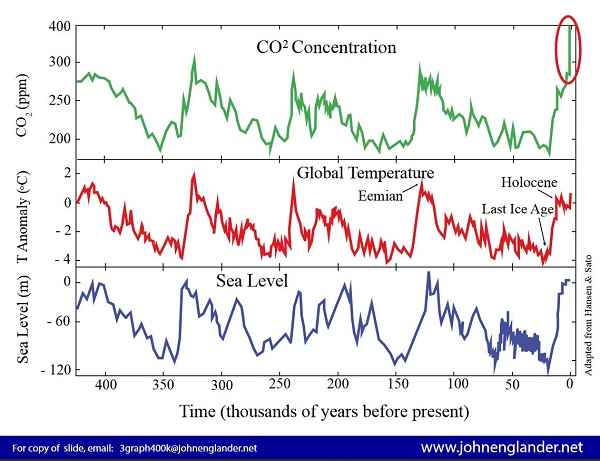
He says:
-
The real big issue of concern is the level of CO2. As shown on the green line in the middle, it has fluctuated between about 180 – 280 ppm (parts per million) over the last 400,000 years. Now the level has shot up like a rocket to 393 ppm, a 40% increase. (Note the line goes way up into the area of the red graph.) This correlates with our emissions from burning fossil fuels, reduction of forest cover, and other factors. The concern is the way that average global temperature moves in concert with CO2.
If temperatures later this century continue to climb, causing all the ice sheets to eventually melt, there will be catastrophe — even if it takes many centuries for that to fully happen. The last time that CO2 levels were in the range near a 1,000 ppm, was about 55 million years ago. At that time there were no polar ice sheets and sea level was approximately 250 feet (75 m) higher than today.
He mentions CO2 at 393 ppm. By now it is actually around 411 and the annual increase is increasing. This graph shows the net GHG forcings growth rate change:
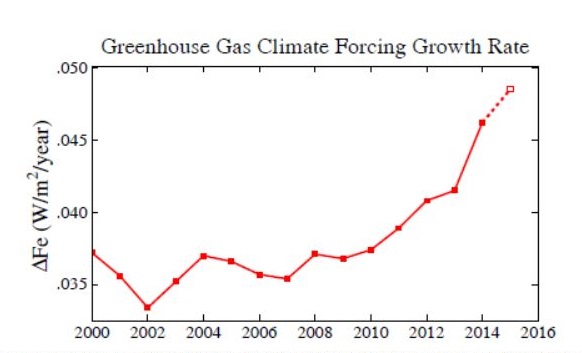
The points are 5-year running means, except 2015 which is three years.
The graph comes from Hansen et al Young People’s Burden: Requirement of Negative CO2 Emissions, which every political candidate should read and be examined on before running for parliament. The references include 2017 sources, so it’s recent.
From page 8:
- Hansen et al. (2008) concluded “If humanity wishes to preserve a planet similar to that on which civilization developed and to which life on Earth is adapted, … CO2 will need to be reduced … to at most 350 ppm, but likely less than that.” And further “If the present overshoot of the target CO2 is not brief, there is a possibility of seeding irreversible catastrophic effects.” (Emphasis added)
Politicians and public officials who blather on about “technology neutrality” in electricity generation including coal should be charged with crimes against humanity.
The urgent task is not just to get net emissions down to zero, it is to go beyond that and remove GHGs from the atmosphere. Yet this is what happened to James Hansen when he went on the streets in the USA:

Update: Hansen et al Global climate changes as forecast by Goddard Institute for Space Studies three‐dimensional model 20 August 1988.
Update 2: It is appropriate here to link to Ian Dunlop’s post:
The fiduciary responsibility of politicians and bureaucrats in the era of existential climate risks.
Australia has signed and ratified the 2015 Paris Climate Agreement which obliges it:
- with the intent of meeting its objectives to limit global average temperature increase to “well below 2C above pre-industrial levels and to pursue efforts to limit the increase to 1.50C”, and “to reach global peaking of greenhouse gas emissions as soon as possible – in accordance with best available science”, recognising that “climate change represents an urgent and potentially irreversible threat to human societies and the planet”.
However:
- Since Paris, our Federal Government has ignored the Agreement, brushing off the increasingly urgent warnings of “the best available science” and ramping up fossil fuel expansion, whilst placing every possible obstacle in the way of low-carbon energy alternatives.
The fact that many Ministers and parliamentarians are climate deniers for ideological or party political reasons, does not absolve them of the fiduciary responsibility to set aside their personal prejudices and to act in the public interest with integrity, fairness and accountability.
This requires them to understand the latest climate science and to act accordingly. It is not acceptable for those in positions of public trust to dismiss these warnings in the cavalier manner which has typified the last few years, particularly when the risk is existential.
Dunlop then turns to the public service, which should give frank and fearless advice. However:
- The December 2017 Review of Climate Change Policy was one of the most dishonest reports ever published by government in the climate arena.
Other examples are given, with an acknowledgement that the 2016 Defence White Paper recognises climate change as a “threat multiplier”.
Generally the public service is not treating climate change with anywhere near the urgency it demands.
-
The Australian Public Service Impartiality Value requires advice given to government to be “apolitical, frank, honest, timely and based on the best available evidence”.
Further, it must be “objective and non-partisan; relevant comprehensive and unaffected by fear of consquences, not withholding important facts or bad news; mindful of the context in which policy is to be implemented, the broader policy direction set by government and its implications for the longer term”.
Henceforth, climate change will determine policy across the spectrum, encompassing national security, defence, energy, health, migration, water, agriculture, transport, urban design and much more.
Given continued urgent warnings from scientists, including the government’s own experts, on the need for far more rapid action, the parlous state of our climate and energy debate and the shortcomings in policy formulation, the Federal bureaucracy is hardly meeting its own standards of fiduciary responsibility to the community.
So:
- In contrast to earlier eras, the concepts of fiduciary responsibility, public interest and public trust, are clearly not understood by the incumbency, from the Prime Minister down. This has to be corrected.
Update 2 September 2018:
Since the above was written, the Turnbull government capitulated completely to fossil fuel interests and their political advocates, to be replaced by a government led by Scott Morrison, intent on actively damaging the planet.
See also:
Reconciling estimates of climate sensitivity
Hansen worries that all hell will break loose
CO2 is scrambling our brains, but will it kill us all?
Science shows the need for urgent climate action
Climate change: the end of civilisation as we know it
IPCC on 1.5°C: the target is wrong, but we have a strong wake-up call

I thought it was important to complete this post to provide an appropriate context for looking at the ACCC report on electricity prices, as the document seems to inhabit a world where there is no pricing of the externalities of burning fossil fuels.
I’ve always wondered how scientists can know the golbal temperature to within a fraction of a degree 35 thousand years ago.
Global even…
Here’s a video from The Australian, dated Jul 13, link here, that shows:
From time interval 0:33: Tony Abbott calling for a focus on reducing power costs, not emissions.
From time interval 1: 18: Deputy Federal Nationals Leader Senator Bridget McKenzie says it’s all about affordability and reliability, and she is “ecstatic” about the ACCC report.
Well, Tony Abbott and Bridget McKenzie, if you are fair dinkum, then you will endorse the building of new solar thermal with thermal storage power generators for Australia – it’s the technology that’s the most affordable, ‘dispatchable’, reliable, and long-term sustainable option, with zero-carbon emissions, that can be deployed in less than 4 years. New coal, new gas and new nuclear don’t come close to meeting all of the same attributes.
Whether politicians and public officials are deniers (or ‘skeptics’) of human-induced climate change science, they are ignoring the undeniable economic arguments for transitioning to renewable energy for electricity generation.
As I’ve said here many times, remove all subsidies and political interference and the market will prevail for the positive.
It looks like GM is trying to express that sentiment too, in his own special way.
Jumpy: We didn’t wait for market forces to get rid of asbestos. What mattered in the end was government action and the cost of damage cases against asbestos suppliers. However, it would have been better to have been banned a lot earlier than it was.
In many ways greenhouse gases are even worse than asbestos because they have the potential to do so much more damage. Market forces are beginning to drive climate action in the power generation industry despite the demands of the coal sniffers to subsidize coal because market forces are going against their beloved coal.
However, we need to be making changes in areas like steel production where market forces are propping up some high emission industries.
When has this ever worked?
John
When people learned asbestos was terrible they stopped buying it.
Remember, Government mandated it’s use in all taxpayer funded projects. I even have a government spec ( paper form ) from 1965 that compelled the builder to use it.
If the average Joe had a choice of energy production method at point of purchase then maybe you could argue the market is driving climate change, they don’t so you can’t.
If solar thermal, as GM says, is cheaper and all the other benefits then the Capitalist will embrace it or go bust.
And let’s face it, the EIS is waved through instantly despite the flaming bird problem.
Or they will mount campaigns to protect their investments in old technology.
Exhibit A: the paid off dinosaurs in the Murdoch media and the LNP fighting for Aussie Aussie Coal. Capitalists hate competition.
zoot
Please put you off topic inanities on the open thread.
I think Brian would prefer I ignore them there.
Brian:
These findings were in English and were readily available. There’s no excuse. But, before we hang the latter-day Red Guards from the nearest yard-arm; let’s find secure, stable alternative employment for all those in the coal, gas and oil industries who will be displaced in the necessary and inevitable crackdown.
Jump:
How do we know how warm or cold it was in the past?
The short answer is through proxies – easy where we have ice cores, it gets harder after that.
Enjoy the read.
Jump, the market has given us fossil fuels, electricity and mass production technologies. Problem is we produced GHGs and used the atmosphere as a dumping ground. Couldn’t see them couldn’t smell them.
It’s one of the biggest market failures ever.
I’ve added the following to the post:
Hansen et al Global climate changes as forecast by Goddard Institute for Space Studies three‐dimensional model 20 August 1988.
The citations include subsequent papers and go on pretty much forever.
Jump (Re: JULY 13, 2018 AT 5:01 PM):
I think with that attitude the Montreal Protocol to ban CFCs would not have happened, and the global chemical industry would have continued to produce ozone depleting chemicals. Where would we have been now without that “political interference“, Jump? Even now, it seems some manufacturers in China are blatantly circumventing the ban. How is the “market” prevailing in China for the positive, Jump?
Where would humanity be without the US government funded NASA space programme? Or the US Airforce operated GPS? These are a few examples of government sponsored programmes (and Australian government funded CSIRO projects, etc.) that the “market”/business has ‘piggy-backed’ upon utilizing knowledge/technologies gained resulting from “political interference”/government largess. Do you think humanity today would be where we are now without “political interference”/government largess? Do you think the “market”/business would have done better without “political interference”? I think not.
Other examples: Immunization programmes, environmental protection, building standards, electrical standards, consumer protection laws, etc. The list goes on…
I agree with Zoot (at JULY 13, 2018 AT 7:00 PM):
Examples: Smoking, Asbestos, CFCs, Fossil Fuels.
As Brian said above in his post:
That requires effective and timely global co-operation. That requires effective global co-operative governance (not a global government).
Well said Geoff, but Jump is immune to evidence and logic.
Geoff, I was referring to your comment,
( your bold )
not all that other stuff. But if you want to raise each item individually on the Open Thread I’ll endeavour to address them there, not here.
As for Government Cooperation, the people have to be convinced first. And they’re evidently not given the governments being elected.
If I’ve got a product I want to sell lots of I’d try to convince the punters it’s the best value compared to its competitors. If it is it’ll go gangbusters and crush the competition, till they go one better, and crush me unless I innovate. These changes can happen before you even notice it started. That’s the market.
You’re trying to get Government to mandate a certain product which in the past has been tragic in some cases and changes move at snails pace.
Imagine you could individually choose which energy source to buy each month, online, as an educated adult.
Not this convoluted, bureaucratically designed, monstrosity of a scrambled dogs breakfast that is the system we have now, that some have the audacity of mendacity to call our “ energy market “ that is not determined by consumers.
Jump (Re: JULY 14, 2018 AT 2:49 PM):
Your comment (at JULY 13, 2018 AT 5:01 PM):
…I took to have a much broader context (and you say explicitly that you have said so in this forum “many times“) than just a response specifically to my comment:
But let me get this straight: Do you agree with my comments (at JULY 14, 2018 AT 11:29 AM) about “all that other stuff“? Or are you sticking with the notion “remove all subsidies and political interference and the market will prevail for the positive” and disagreeing with “all that other stuff“?
You say:
Perhaps you forgot about Brian’s post AUSTRALIANS SPEAK: WHAT DOES THE GOVERNMENT HEAR? where it shows the results of a poll indicating Climate Change is ranked third as a critical threat?
I think it’s evident that some elected governments are not acting in its citizens’ best long-term interests. See David Spratt’s comments on this issue in my comment here.
It’s evident that Hansen got it right 30 years ago, and governments have predominately ignored his message since then at our peril.
I’ve added an update extracting relevant parts of link to Ian Dunlop’s post:
The fiduciary responsibility of politicians and bureaucrats in the era of existential climate risks.
Which Geoff M has reminded us about many times.
Brian (Re: JULY 15, 2018 AT 3:58 PM):
Posted today, at RenewEconomy.com.au is another op-ed by Ian Dunlop headlined Minerals Council still dangerously wrong on coal and climate, link here. I think this is an interesting observation:
I wonder whether ASIC (?) will prosecute the MCA directors for “misleading and deceptive” conduct?
The first comment below is from Tim Buckley (I presume he is the same Tim Buckley from IEEFA).
You may wish to check out the EV Oil Demand Displacement Interactive Tool, published at the beginning of this month (and now active) by the Carbon Tracker Initiative, link here. It says:
We need every tool/solution available to bring down emissions.